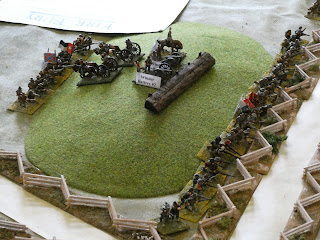This week we are in eastern Europe again, with Steve's Muscovites facing my Polish army. A few months ago, the Muscovites began building a redoubt to cover a vital border river crossing. The local Polish forces crossed the river and demolished the part completed work. Undeterred, the Muscovites returned with a much larger force and began construction again, expanding the project to include a second redoubt on a nearby hill. With the first redoubt built, the workers have now moved to start work on the second. Behind the hills are two camps, one for the infantry and one for the cavalry. Within the infantry camp is the large gun which will be installed in the new redoubt and also a gulay gorod. Two units of light cavalry skirmishers are deployed forward watching for Polish forces attempting to cross the ford.
 |
| The Muscovite feudal cavalry |
Heading towards the ford is a Polish force consisting of 1 unit of Hussaria, 1 unit of Cossack skirmishing light cavalry and 4 units of pancerni. Accompanying them are a brigade of infantry, 2 units of haiduks, 1 unit of levy and 1 'German' regiment (mixed pike and shot), together with a light gun.
The Muscovite deployment, showing the newly constructed redoubt with chevaux-de-frise in front of it.
 |
| The Polish vanguard deployed |
Victory conditions are simple, the Poles need to destroy the Muscovite works, the Muscovites to prevent this.
Taking advantage of an early morning mist the Polish Cossacks and Hussaria have crossed the ford and deployed before the Muscovite skirmishers are aware they are there. Behind the Polish vanguard the remaining pancerni are waiting to cross.
 |
| The Polish vanguard prepare to advance |
Wasting no time, the Cossacks charge the opposing skirmishers, who released some arrows and then fell back behind the supporting unit. Uncharacteristically, the Hussars declined to move forward to support the Cossacks. (Sulking because they had not been given the lead?). This prevented further units crossing the river, the first of several delays which hampered the Polish advance.
The Muscovite skirmishing cavalry charged the Cossacks and perhaps re-organising after their advance the Cossacks were caught at the halt. In no time they were falling back on their supports and, on being charged and bested in melee again, routed through the Hussars and pancerni; last being seen disappearing into the distance across the steppe. The Hussars were also swept back over the river, an ignominious start to the battle for these elite troops.
 |
| The first Polish advance repulsed |
Luckily for Polish hopes, the brigade commander rallied them and then personally led them back over the ford. Swiftly deploying into line, the Hussars swept forward, totally overwhelming the Muscovite skirmishers and routing them. By now the Muscovite feudal cavalry had advanced and the leading unit charged the Hussars. Ignoring the difference in numbers, the Hussars counter-charged and defeated their opponents, sweeping forward to drive back a second unit of feudal cavalry.
 |
| The feudal cavalry defeated |
The Muscovite infantry, artillery and Gulay Gorod had moved forward on the Muscovite left, though the latter had been rather slow. This had delayed the Soldatski and a unit of Streltsy, but the remainder of the infantry had moved up to the new redoubt and then seeing no Polish infantry, forward to the chevaux-de-frise. Behind them, the Gulay Gorod had eventually sorted itself out and deployed to cover the flank of infantry. The Polish commander's decision to push all his cavalry forward before sending the infantry against the redoubt proved to be a big error. The Streltsy were able to fire into the flank of the Pancerni as they advanced, inflicting losses which reduced their effectiveness in the combat against the Muscovite cavalry. Even so, the skirmishers were pushed back once again and the feudal cavalry came under renewed pressure. One of the Pancerni units charged the Soldatski. Although hard pressed the Soldatski stood their ground and after a tough struggle beat back the Polish horsemen.
 |
| The Streltsy advance from the redoubt |
 |
| The Soldatski defeat an attack by Pancerni |
 |
| The Gulay Gorod in position |
The delayed Polish infantry eventually crossed the ford and moved towards the redoubt; the two haiduk regiments in the front and the levy following on behind. The heavy gun had now reached the redoubt and the artillery crew readied it for use. However, they could not fire because the wagon with the ammunition was still struggling up the hill.
As the haiduk regiments closed on the chevaux-de-frise the Streltsy opened fire. Halting, the haiduk replied and volleys were exchanged for some time. One of the Streltsy units was forced to fall back to reform, but all this did was to give the heavy artillery, (now supplied with ammunition), a clear field of fire. Under artillery fire from the redoubt and also long distance fire from the light artillery with the Gulay Gorod, the haiduk units wilted. Eventually, they had to retire due to their losses. This left the levy and although they managed to fire a volley which rocked the Streltsy facing them, they were too weak to push home their advantage.
On the Muscovite right the cavalry melees continued, sweeping back and forth as the advantage shifted. Eventually the superior numbers of the Muscovites prevailed, aided by the flanking fire from their infantry. One by one the Pancerni units were pushed back and inevitably their losses ended in rout. The Hussaria tried to stand against the tide, but even they had to fall back.
 |
| The rout of the haiduks |
 |
| The Pancerni are driven back |
Sensing that he could not carry out his orders, the Polish commander ordered a retreat; his rearguard covering the ford to dissuade the Muscovites from following up.










































